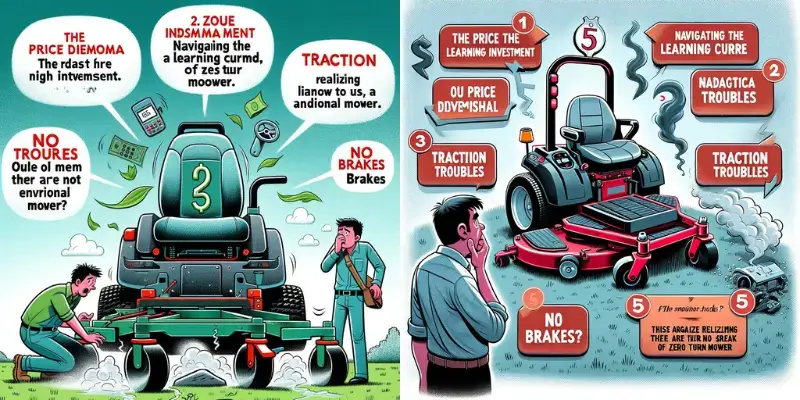5 DISADVANTAGES OF ZERO TURN MOWER
Maintaining a well-kept lawn is a regular chore for many homeowners, often accomplished with the help of zero-turn mowers. These machines are renowned for their ability to swiftly maneuver through tight spaces and obstacles, aiding in efficient lawn care.
However, besides their advantages, there are several drawbacks that users should be aware of while buying these machines. This blog aims to shed light on these downsides, offering a detailed exploration of the limitations associated with zero-turn mowers.
After understanding these shortcomings, a homeowner, can make informed decisions and take necessary measures to mitigate these issues for a smoother and more effective lawn care experience.
5 DISADVANTAGES OF ZERO TURN MOWER: YOU SHOULD MUST KNOW
When you are going to buy a zero-turn lawn mower it is mandatory to thoroughly read and analyze the advantages and disadvantages of using these mowers. There are multiple disadvantages of the zero-turn mower but I will explain those you should know:
The Price Dilemma: Initial Investment
Comparative Costs:
Zero-turn mowers could cost you several thousand dollars more than their conventional counterparts.
Value vs. Price:
While the initial investment might seem steep, zero-turn mowers often provide better maneuverability and time efficiency, offering long-term benefits for lawn care enthusiasts.
Budget Balancing Act:
If you’re focused on immediate cost-effectiveness rather than immediate efficiency gains, the higher upfront cost might make you hesitate.
Navigating the Learning Curve
Handling the Unfamiliar
Getting the hang of a zero-turn mower isn’t as easy as hopping onto a traditional riding mower. These machines come with a unique steering system and control levers that take some getting used to.
Taming the Maneuvering
New users might find themselves in a bit of a pickle while trying to master precise maneuvering. It’s common to face challenges in controlling the mower effectively, which can result in accidental lawn damage until users become comfortable handling the machine with finesse.
Overcoming the Hurdle
Taking the time to learn and practice handling a zero-turn mower is key. While it might start a bit bumpy, with practice, users can gain the necessary control and finesse, ensuring smooth and damage-free lawn care sessions.
Traction Troubles in Zero Turn Mowers
Zero-turn mowers, with their swift maneuverability, sometimes face challenges with traction. Here’s why:
Unique Design:
The design that enables these mowers to pivot quickly can sometimes compromise their traction, especially on slippery or uneven terrain.
Loss of Grip:
In wet or steep areas, these mowers might struggle to maintain a solid grip, leading to skidding or sliding.
Tackling Traction Issues
Tire Maintenance: Ensuring proper tire pressure and regular checks on tire treads can help maintain better traction.
Mowing Technique: Adjusting mowing patterns to avoid steep slopes or damp areas can reduce traction problems.
Alternate Solutions: Some users opt for adding tire chains or selecting specialized tires for improved traction on challenging terrains.
The Balancing Act
While zero-turn mowers offer unparalleled maneuverability, their traction limitations call for careful consideration of the terrain. By adopting specific maintenance practices and being mindful of where and how you mow, you can alleviate traction issues for smoother lawn care sessions.
No Brakes? Understanding Zero-Turn Mower’s Brake System
Missing Brake Pedals
One notable aspect of zero-turn mowers is the absence of traditional brake pedals. Instead of using a foot pedal to control brakes, these mowers operate on a different system.
Control Levers: The Brake Substitute
Zero-turn mowers rely on control levers to manage their movement and speed. By pushing the levers forward or pulling them back, users control the mower’s speed and direction. Releasing or moving the levers to the neutral position effectively halts the machine’s movement.
Maneuvering without Brakes
The design’s emphasis on swift turns and maneuverability means there’s no separate brake pedal. Users need to rely on effectively using the control levers to slow down or stop the mower when needed.
Learning the Technique
Mastering this different braking technique might take some practice. Users need to get accustomed to the lever-based control system to effectively manage speed and movement without conventional brake pedals.
Environmental Impact of Zero-Turn Mowers
Fuel Emissions Concerns
Like many gasoline-powered machines, zero-turn mowers contribute to environmental pollution through exhaust emissions. These emissions contain pollutants harmful to the environment, including carbon monoxide, hydrocarbons, and nitrogen oxides.
Noise Pollution
Zero-turn mowers, often powered by gasoline engines, can generate considerable noise during operation. Prolonged exposure to this noise pollution can be disruptive and have adverse effects on surrounding wildlife and residential areas.
Mitigating the Impact
- Regular Maintenance: Proper maintenance, including tune-ups and using clean fuel, can reduce emissions and improve fuel efficiency, lessening the environmental impact.
- Electric Alternatives: Electric-powered zero-turn mowers offer a greener option with zero emissions and reduced noise pollution, making them a more environmentally friendly choice.
- Mindful Usage: Reducing unnecessary usage and adhering to recommended maintenance practices can minimize the environmental impact of zero-turn mowers.
While zero-turn mowers contribute to pollution, adopting responsible usage habits and considering eco-friendly alternatives can help mitigate their environmental impact.
Should You Buy a Zero-Turn Mower?
Deciding whether to purchase a zero-turn mower depends on various factors. Here are some considerations to help you make an informed choice:
Advantages of Zero-Turn Mowers:
- Efficiency: These mowers offer exceptional speed and precise maneuverability, reducing mowing time significantly.
- Maneuverability: Their ability to turn sharply and navigate obstacles makes them ideal for complex landscapes.
- Comfort: Zero-turn mowers often provide a more comfortable ride due to their design and ergonomic features.
Factors to Consider:
- Learning Curve: Mastering the operation might take time, especially for new users.
- Traction Issues: They can struggle on slippery or uneven terrains, affecting their performance.
- Initial Cost: These mowers come with a higher upfront investment compared to other types.
- Environmental Impact: Gasoline-powered models contribute to pollution, although electric options offer a greener alternative.
Making the Decision:
Consider your lawn size, terrain type, budget, and environmental concerns. If you have a large, open lawn and value speed and precision, a zero-turn mower might be a great choice. However, for smaller areas or if environmental impact is a concern, other mower types might be more suitable.
Evaluate the advantages against the potential drawbacks to determine if a zero-turn mower aligns with your specific needs and preferences for lawn care.
FREQUENTLY ASK QUESTIONS (FAQs)
BOTTOM LINE:
Understanding the drawbacks of zero-turn mowers empowers buyers to make informed decisions tailored to their specific lawn care needs. Every type of mower comes with its set of advantages and disadvantages. For example, while walk-behind mowers require more physical effort, automatic mowers can be the priciest among various options. It’s essential to weigh these factors against your preferences and the demands of your lawn.
Before making any purchase, thorough research becomes the cornerstone of a well-informed decision. Taking input from consumer review sites and understanding the honest experiences of users helps grasp the nuances of each mower type.







